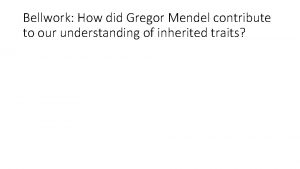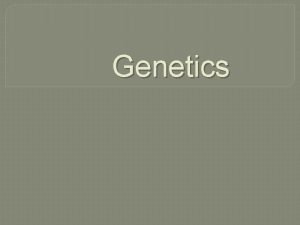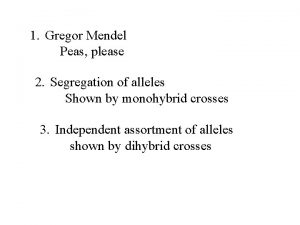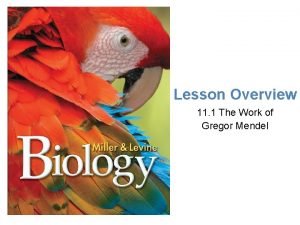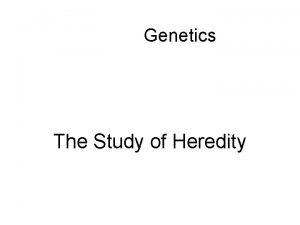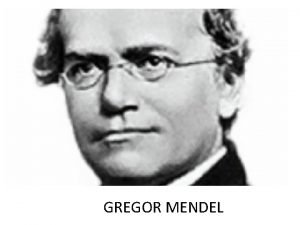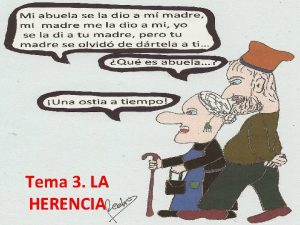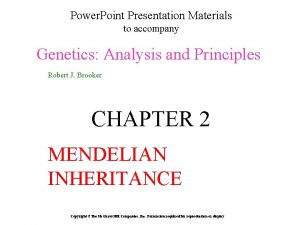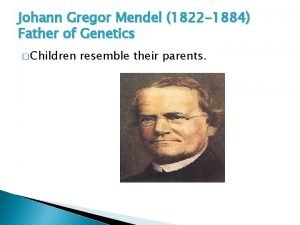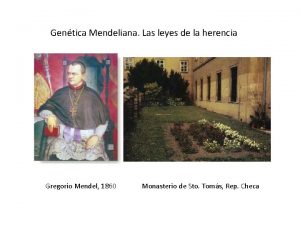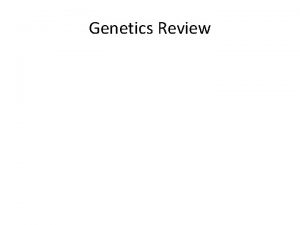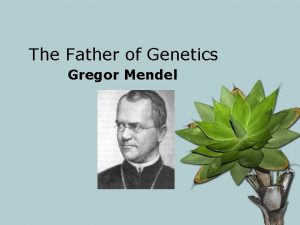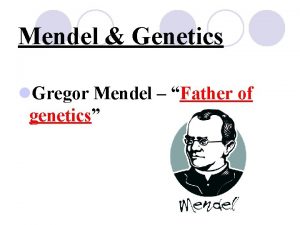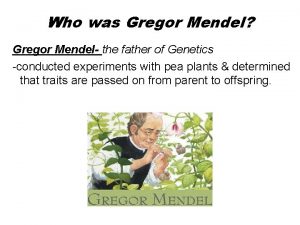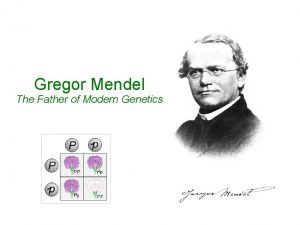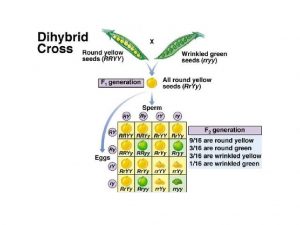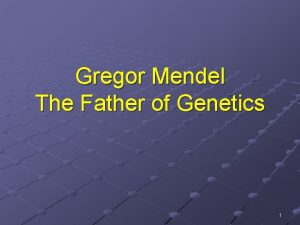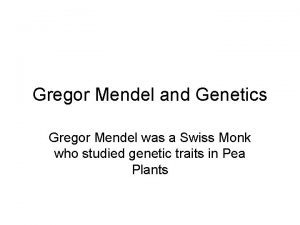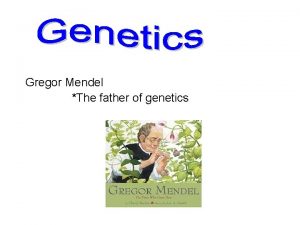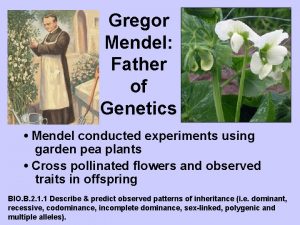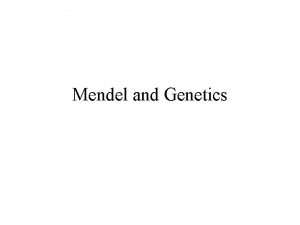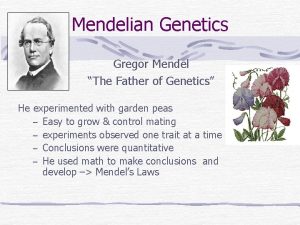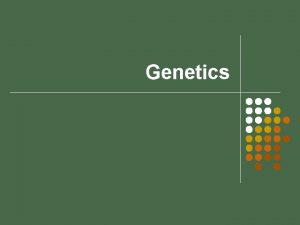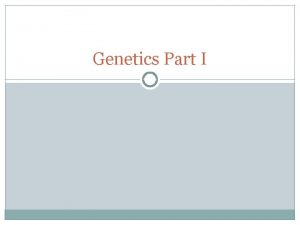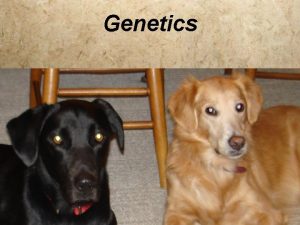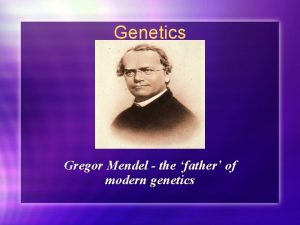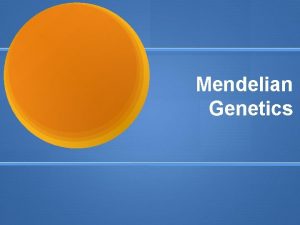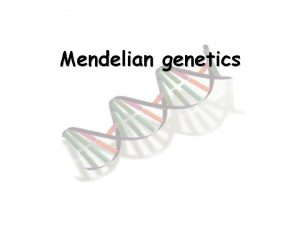Gregor Mendel Father of genetics Mendel Successes 1






























- Slides: 30

Gregor Mendel “Father of genetics”

Mendel Successes • 1 st to predict how traits are transferred from one generation to next • Successful b/c studied only one trait at a time to control variables & analyzed his data mathematically

Mendel’s experiments • Self-pollination true-breeding parent, only 1 plant • Cross-pollination (making a cross) offspring from two different parent plants

More on Mendel’s experiments • Mendel studied 7 traits on pea plants - Seed shape & color, pod color & shape, flower color, flower position, & plant height • Conducted monohybrid crosses looking at only 1 trait • Example – Flower color


What’s going on? • The white flower trait had reappeared. • Mendel repeated for other traits and in every case he found that one trait seemed to disappear in the 1 st generation only to reappear unchanged in ¼ of the 2 nd generation.

Mendel’s hypothesis 1. Organisms have 2 factors that described each trait alleles 2. Inherited one allele from father & other from mother


Explaining Mendel’s results • A purebred parent plant would have 2 identical alleles for purple flowers (PP) or 2 alleles for white flowers (pp) • F 1 offspring have 1 allele for purple flowers & 1 allele for white flowers (Pp) • F 2 offspring - pp, Some PP, Pp

Mendel’s Law of dominance • Some alleles are dominant (trait is expressed in the offspring) & other alleles are recessive (trait is only exhibited if dominant is absent) • Ex: Purple & white flowers

Law of segregation • Alleles for a trait will separate when the sex cells (gametes) are formed during meiosis. • Evidence – F 2 offspring show recessive trait.

Law of Independent Assortment • Genes for different traits are inherited independently from each other • Mendel discovered this through his experiments w/dihybrid crosses (2 parents w/2 different traits) • Ex: tall, yellow pea plant with a short, green pea plant

Environment affects gene expression • Internal - Age, gender (hormonal differences) – Ex: male bird feathers colorful • External - Temperature, nutrition, light, radiation, chemicals, viruses – Ex: leaves at top of trees

Review • Phenotype –What the organism looks like (physical appearance) –Ex: brown hair • Genotype –genetic makeup of an organism (we cannot see this) –Ex: Bb, BB

Two forms of Genotype • Homozygous –both identical alleles are either dominant or recessive. –Ex: BB or bb • Heterozygous –different alleles, one dominant & one recessive –Ex: Bb


Punnett Squares (PSq) • Developed in 1905 by Reginald Punnett. • Used to predict & compare possible genetic variations resulting from a cross • Probabilities, not exact results

Symbols used in PSq • Original parents P 1 generation • Offspring of the parent plants F 1 generation • Offspring of the F 1 generation F 2 generation

Example

Steps to solving PSq 1. Identify the dominant & recessive alleles 2. Write the genotypes of the parents 3. Determine the possible gametes the parents can produce (how the alleles will separate)

4. Enter the possible gametes at top (#1 parent) & side (#2 parent) of the PSq 5. Complete the PSq write the alleles from the gametes in the appropriate boxes 6. Determine the phenotypes of the offspring and percentages of each

PSq Practice • Heterozygous yellow seeds x homozygous green seeds Y • Key : – Y yellow seeds –y green seeds y y y

Answer Y y y Yy yy

Now try this sex-linked trait • Heterozygous normal female x normal male N h X X • Key : – X N normal X – X h hemophilia Y – Y normal N

Answer X X Y N X X N X Y N N h X X N X Y h h

Now try problems on: • Working with Punnett squares worksheet STOP click here


Dihybrid cross – like a puzzle • Can 2 parents with Heterozygous round, yellow seeds produce offspring with wrinkled, green seeds? • 1 st – determine possible gametes/ allele partners – – First Outside Inside Last • Set up PSq boxes


Practice Dihybrid Cross • Heterozygous Purple Flower & Homozygous Tall X Homozygous white flower & Heterozygous Tall Key: F purple flower T tall f white flower t short
 Gregor mendel father of genetics
Gregor mendel father of genetics Gregor mendel’s principles of genetics apply to
Gregor mendel’s principles of genetics apply to How did gregor mendel contribute to genetics
How did gregor mendel contribute to genetics Gregor mendels principles of genetics apply to
Gregor mendels principles of genetics apply to Gregor johann mendel
Gregor johann mendel What did gregor mendel research
What did gregor mendel research Gregor mendel austrian monk
Gregor mendel austrian monk Gregor mendel referat
Gregor mendel referat Who is gregor mendel and what is he famous for
Who is gregor mendel and what is he famous for Tt x tt punnett square
Tt x tt punnett square Mendels theory
Mendels theory Blood types
Blood types Gregor mendel laws
Gregor mendel laws Gregor mendel chart
Gregor mendel chart Gregor mendel 1865
Gregor mendel 1865 Gregor johann mendel steckbrief
Gregor johann mendel steckbrief Gregor mendel
Gregor mendel Gregor mendel
Gregor mendel What did gregor mendel do
What did gregor mendel do Why did mendel prevent his plants from self-pollinating?
Why did mendel prevent his plants from self-pollinating? Gregor mendel
Gregor mendel Who was mendal
Who was mendal Alelos
Alelos Gregor mendel laws
Gregor mendel laws Chapter 12 lesson 1 the work of gregor mendel
Chapter 12 lesson 1 the work of gregor mendel Gregor mendel
Gregor mendel Gregor mendel data
Gregor mendel data Cruza dihibrida
Cruza dihibrida Gregor mendel austrian monk
Gregor mendel austrian monk How many pairs of chromosomes
How many pairs of chromosomes Mendel genetics
Mendel genetics


